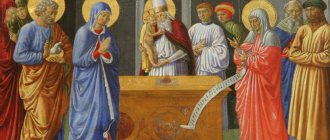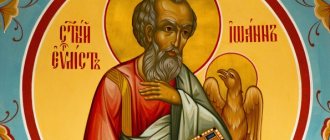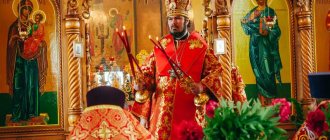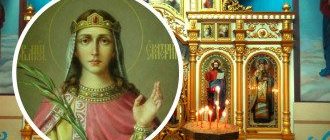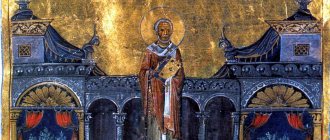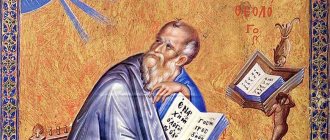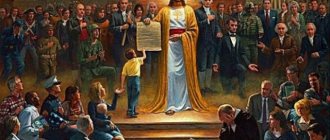John the Theologian is a beloved disciple of Jesus Christ, one of the authors of the Gospel, the only one of the 12 apostles who was granted a meeting with God in Heaven and died his own death.
The son of the fisherman Zavedeev and his wife Salome, left his parents, and with his brother followed the Teacher at His first call. For his ardent desire to preach the Gospel, he was called the son of thunder.
Biography
The Apostle John, later called John the Theologian, was known as a particularly beloved disciple of Christ. Jesus emphasized the sacrifice and spiritual purity of John, and therefore John became one of the apostles especially close to Christ.
Apostle John
The Lord Himself nicknamed John “Son of Thunder.” Hearing the call of the savior, the boy left his home and rushed after the Preacher. It was John who fell to the chest of Jesus at the last meal of Christ, and later in the texts of the books he proved that the Lord personifies love.
Prayers before the icon
Troparion, tone 2
Apostle, beloved of Christ God, / hasten to deliver the irresponsible people, / he receives you, falling, / who fell on Persia and was received. / Pray to him, O Theologian, / and the surrounding cloud of tongues disperse the crowds, // asking us for peace and great mercy.
Translation: Apostle, beloved by Christ God, hasten to deliver defenseless people! The One who accepted you when you fell to His chest accepts your prayer. Pray to Him, O Theologian, to dispel the approaching cloud of paganism, asking for peace and great mercy for us.
Troparion, voice 2
Apostle, beloved of Christ God, / hasten to deliver the irresponsible people, / he receives you, falling, / who fell on the Persian received. / Pray to him, O Theologian, / and disperse the present darkness of tongues ati, // asking us for peace and great mercy.
Translation: Apostle, beloved by Christ God, hasten to deliver defenseless people! The One who accepted you when you fell to His chest accepts your prayer. Pray to Him, O Theologian, to dispel the approaching darkness of paganism, asking for peace and great mercy for us.
Kontakion, tone 2
Your greatness, virgin, who is the storyteller?/ Perform miracles, and pour out healings,/ and pray for our souls,// as the Theologian and friend of Christ.
Translation: Who can tell about your greatness, virgin? For you pour out miracles and pour out healings, and intercede for our souls, as the Theologian and friend of Christ.
Greatness
We magnify you, Apostle of Christ and Evangelist John the Theologian, and honor your illnesses and labors, in which you worked in the gospel of Christ.
First prayer
Oh, great apostle, loud-voiced evangelist, most graceful theologian, seer of the secrets of ineffable revelations, virgin and beloved confidante of Christ John! Accept us, sinners, who come running under your strong intercession and protection. Ask the All-Generous Lover of Mankind, Christ our God, Who poured out His blood for us, His needless servants, before you combed, so that He may not remember our iniquities, but may He have mercy on us and do with us according to us His kindness: may He grant us health of soul and body, all prosperity and abundance, instructing us to turn it into the glory of Him, the Creator, Savior and our God, after the end of our temporary life from the merciless torturers in aerial ordeals and huts He guides us, and so may we reach, through you, the waters and the covering of the mountainous city of Jerusalem, You have seen its glory in revelation, and now you enjoy endless joys. O great John! Save all Christian cities and countries and all who call on your name from famine, destruction, cowardice and flood, fire and sword, invasion of foreigners and internecine warfare; Deliver us from all misfortune and adversity, and with your prayers turn away the righteous wrath of God from us, and ask us for His mercy. O great and incomprehensible God! Behold, for Your supplication we offer Saint John, to whom You have vouchsafed unspeakable revelations, accept intercession for us, grant us the fulfillment of our petitions for Your glory, and moreover make us spiritually perfect the chance to enjoy, endless life in Your Heavenly abodes! O Heavenly Father, Creator of all things, Omnipotent King! Touch our hearts with grace, so that, melting like wax, they will be poured out before You and mortal spiritual creation will be created in honor and glory of Yours, and Your Son, and the Holy Spirit. Amen.
Second prayer
Oh, great and all-praised apostle and evangelist John the Theologian, confidante of Christ, our warm intercessor and quick helper in troubles! Pray to the Lord God to grant us forgiveness of all our sins, even if we have sinned from our youth throughout our lives, in our deeds, words, thoughts and all our feelings; at the exodus of our souls, help us, sinners (names), to get rid of airy ordeals and eternal torment, and with your merciful intercession we glorify the Father and the Son and the Holy Spirit, now and ever and ever eki centuries. Amen.
( 4 ratings, average: 5.00 out of 5)
Childhood and youth
Church literature claims that the family of the Apostle John traces its origin back to King David. The betrothed husband of the Blessed Virgin Mary, Joseph the Carpenter, had a daughter, Salome, who married Zebedee. Salome and Zebedee had two sons: James and John.
Young Apostle John
Evangelist Mark mentions in the writings that John, his older brother James and his father were fishing from a boat when the call of Christ sounded. The brothers left their catch and their father and followed the Lord. Luke in the writings adds that the newly minted apostles were present at the miraculous fishing and, impressed, turned to the Savior. The young men did not doubt their choice for a moment: they left everything they had and followed the Teacher.
For his impulsive character, keen sense of justice and masterful use of words, Christ nicknamed John the Theologian “Son of Thunder.” These features clearly manifested themselves during the ninth and last walk of the Lord through Galilee: Jesus wanted to go to Jerusalem, but before that he sent messengers to the Samaritan village.
Apostle brothers James and John
However, the residents of the settlement did not accept the Savior. Then John and his brother Jacob asked Christ if they could call fire from heaven to punish the inhabitants of the Samaritan village, but the Lord stopped the excited apostles, because Jesus brings salvation to people, not punishment.
The Apostle John, together with his brother James, were especially close to Peter and were considered closest to the Lord.
Christian service
Once on the shore of the Sea of Galilee, Christ preached a sermon to the people. Among other people, the chairman of the local Synagogue, Jairus, approached Jesus and told the Savior that his daughter was dying. The Lord went to Jairus’ daughter to heal her. On the way to Jairus's house, the messenger told Christ that the girl had died, but Jesus followed her and raised the girl. Only 3 of the 12 apostles witnessed this miracle: Peter, James and John.
John the Theologian
In addition, John the Theologian is the only one of the apostles who was at the Life-Giving Cross. There Jesus instructed John to take care of the Virgin Mary as if he were his own mother.
It is traditionally believed that John the Theologian became the author of five books of the New Testament. The fourth book of the New Testament is called the Gospel of John, although scholars now express doubts about the authorship of the book. For a long time, John preferred oral sermons, but after writing the Gospel of Mark and Luke, John was increasingly asked about the early deeds of the Teacher, which he outlined in his book.
Later, for a wide circle of believers, “The First Council Epistle of the Holy Apostle John the Theologian” was written, which was also included in the New Testament. It is interesting that this book also does not formally have an author, although he is attributed to John the Theologian. The style of speech, the use of phrases and thoughts, as in the Gospel of John, allows us to attribute the book to the authorship of the Apostle John. The book dates back to approximately 90 AD.
John the Evangelist writes the Bible
The book is based on the theme of love in its broadest sense. Moreover, the apostle John shows Jesus as the Word of God. Chapter 5 of the work contains the first mention of the Holy Trinity in the history of Christianity in the following formulation: “Father, Word and Holy Spirit,” supporting its vision of God the Son (Jesus) with the Word.
However, researchers who have studied the “First Conciliar Epistle of the Holy Apostle John the Theologian” point out that this thought does not belong to the author, but is an insertion made much later in order to establish the doctrine of the Trinity. On the pages of the “Message” the author tried to convey the main idea about the unity and inseparability of God and love.
John the Evangelist hugs Jesus Christ
The authorship of the shortest book of the New Testament also belongs to John. The book is called “The Second Council Epistle of the Holy Apostle John the Theologian.” Considering that on the pages of the “Epistle” the author calls himself an elder, and the work dates back to the 90s of the 1st century AD, as well as the similarity of style with previous books, allows scientists to attribute the book to the works of the Apostle John.
In meaning and content, the second “Message” repeats the first, but in a much more abbreviated form. The work focuses on brotherly love between Christians and a call to be wary of the harmful influence of false teachings. Particular attention is drawn to the dedication of the “Epistle” to the “beloved lady,” but researchers agree that this name refers to a community of Christians.
Apostles John and Peter
“The Third Conciliar Epistle of the Holy Apostle John the Theologian” in general terms repeats the previous books both in style and in subject matter. It is noteworthy that the Roman historian Eusebius of Caesarea, describing the history of the Christian church, never mentions the presence in the New Testament of the “Third Council Epistle of the Holy Apostle John the Theologian.”
The first mention of the book dates back to the second half of the 4th century AD, after the Council of Laodicea, dedicated to issues of church government and Christian piety. In particular, Rule 59 prohibits reading biblical books that are not included in the biblical canon of the Old and New Testaments. In the list given in the next rule, the “Third Council Epistle of the Holy Apostle John the Theologian” appeared. However, researchers do not doubt the authorship of the book.
Jesus Christ and the Apostle John
In addition, the “Third Council Epistle of the Holy Apostle John the Theologian” is no longer dedicated to Christian communities in general, but specifically to Gaius. However, the identity of Gaius, to whom the book is dedicated, has not been established. Also, more than once in the “Message” a certain Diotrephes is mentioned, holding a high position in the Church. The actions of Diotrephes, who did not accept wandering Christians and even threatened them with “administrative punishment” up to and including excommunication, were condemned by John the Theologian.
The book of the Revelation of Jesus Christ, also known as the Apocalypse of John or the Revelation of John the Theologian, also belongs to the pen of John the Theologian. This work completes the New Testament. Unlike all previous books of John, the Apocalypse reveals the theme of events that will precede the Second Coming of Jesus Christ to earth. Among such events, the author mentions both natural disasters (fire falling from heaven, etc.) and miracles (appearances of angels, resurrection of dead people).
Icons of John the Evangelist
Also in the Apocalypse, the author more than once mentions his name - John, and also talks about the events that he witnessed. While on the small Greek island of Patmos in the Aegean Sea, John heard a voice from behind, ordering him to write in a book what he saw. In this regard, the authorship of the Apocalypse is sometimes attributed to John of Patmos, who, however, is identified with John the Theologian.
However, researchers argue about the authorship of “Revelation”, since the style and language of the book differ significantly from the “Conciliar Epistles” and the Gospel. However, Metropolitan Hilarion explains this fact by the fact that the author was faced with the need to write about the realities of the New Testament in the language and symbols of the Old Testament.
In addition, the German theologian and researcher of Christianity Wilhelm Busse conducted an analysis of the texts, as a result of which he established that the syntax and lexical phrases correspond to the earlier texts of John the Theologian, thereby confirming his authorship. A Russian researcher who worked on the interpretation of the texts of Holy Scripture, Alexander Pavlovich Lopukhin, also agreed with Busse.
John the Evangelist in a cauldron with hot oil
Modern researchers still question the fact that the “Apocalypse of John” was written by John the Theologian. Thus, in the book of the Archpriest of the Russian Orthodox Church Alexander Vladimirovich Me “Reading the Apocalypse”, as well as Donald Guthrie’s “Introduction to the New Testament”, the idea is clearly visible that among the apostles there were at least 3 Johns, who later merged into a single collective image.
Details of the biography of John the Theologian became known from church writings. After the death of the Virgin Mary, John became a preacher, traveling through the cities of Asia Minor, accompanied by a disciple named Prochorus. Considering that the sermons of John the Theologian were often accompanied by miracles, there were more and more converts to Christianity.
When the Roman Emperor Nero began persecuting Christians, John was arrested and sent to Rome. The court decided to execute the preacher, however, after drinking poison, John remained alive. Then the judges decided to put the apostle in a cauldron of boiling oil, but even then John the Theologian remained unharmed. Then the old preacher was sent into exile to the island of Patmos in the Aegean Sea, accompanied by a disciple.
John the Evangelist on the island of Patmos
The ship on which John, his disciple and the nobles were sailing was caught in a storm, and the noble young man fell overboard. The apostle prayed for a long time about the fate of the young man, and in the morning the waves carried him to the shore alive and unharmed.
Arriving on the island, the Apostle John converted most of the inhabitants to Christianity, performing a number of miraculous healings, and also cast out demons from the pagan temples on the island. A preacher lived with his disciple in a cave far from people, where he indulged in prayer. There, more than once John heard the voice of the Lord commanding him to write books for the glory of God. The local sorcerer Kinops also lived on the island, converting the inhabitants to paganism. After the prayer of John the Theologian, the waves of the Aegean Sea swallowed Kinops forever, and the rest of the local residents converted to Christianity.
What was John's last journey?
The only one of the apostles who saw the terrible persecution, survived it and died a natural death, wrote the Good News to his descendants, leaving a testimony of True love - John the Theologian. With the advent of Emperor Nerva to the Roman throne, who replaced the evil Domitian, all prisoners were released.
John returned to Ephesus, where he lived in the house of Dorn, who had been resurrected by him, baptized people, preached the Word of God, healed and resurrected by the power of the Blood of Jesus.
Jesus prophetically predicted Peter's martyrdom, emphasizing that each apostle had his own destiny. The disciples thought that the Savior promised immortality to John, but the Lord said that he would not die.
According to historical information, the apostle lived for a hundred years; there is no description of his burial, but legends say that the still living John was buried alive at his request by his disciples. After opening the grave some time later, everyone found it empty. It is possible that, like Enoch and the prophet Elijah, the beloved disciple was taken to Heaven alive.
Important! On October 8, the day the saint was buried, the smell of incense was heard over the place of his grave, indicating the presence of the prophet among the living. The Orthodox Church celebrates October 9 as the day of veneration of John the Theologian.
Memory
Even during his lifetime, John the Theologian was honored in the church. Thus, on the icon “John the Theologian in Silence,” the apostle is depicted with an Angel conveying to him the Word of the Lord, and on the pandatives of Orthodox cathedrals the Saint is depicted with an eagle, which symbolizes the soaring thought of the apostle.
Icon “John the Theologian in Silence”
Among the exploits of the Apostle John, church traditions tell about the resurrection by John of the young man Domnus and his father Dioscorides. In addition, at a festival dedicated to the pagan goddess Artemis, John accused those gathered of worshiping idols and called sizzling heat on their heads, causing the death of 2 hundred people. By faith and the will of the Apostle, the dead were resurrected and accepted Christianity.
The memory of the Apostle John the Theologian is revered on May 8 and June 30 annually. This holiday is named after the Council of the Twelve Apostles. On September 26, Orthodoxy celebrates the repose of John the Theologian (Catholics celebrate December 27). On the day of memory of John the Theologian, divine services are held in churches, and a candle burns with imperishable light, illuminating the path to heaven, in memory of the apostle. At the service, the clergy remember the life of John the Theologian and glorify his exploits.
There are no relics of John the Evangelist, but his grave is located in the city of Selcuk
The last disciple of Christ, at the end of his earthly journey, died in a rather unusual way. John the Theologian ordered his disciples to bury him alive. Subsequently, no relics were found in the grave. The grave is located in the city of Selcuk, near Ephesus.
John ordered himself to be buried alive and disappeared from the grave. According to legend, this place annually released a healing substance resembling dust on May 8 (May 21, new style). Therefore, this date is the day of remembrance of the apostle.
Tomb of John the Evangelist
